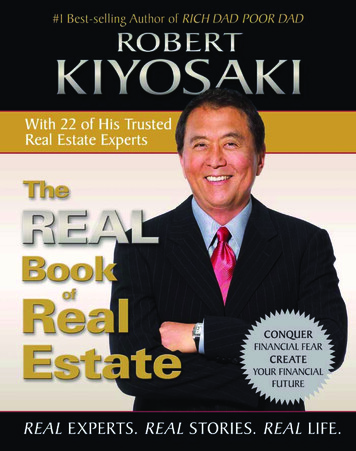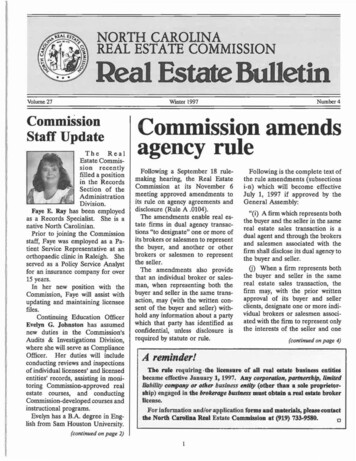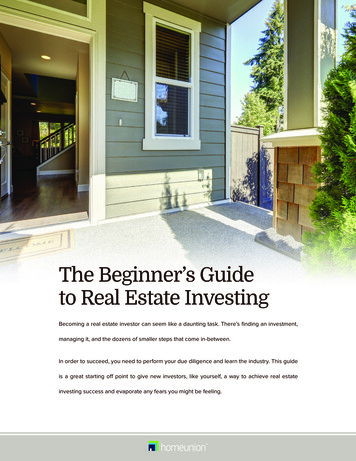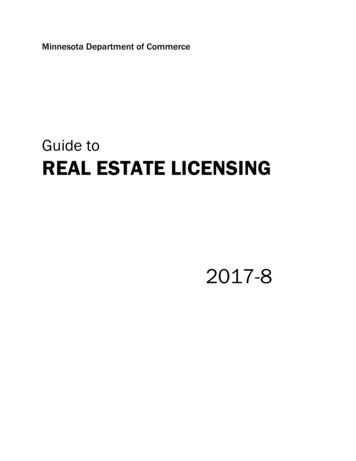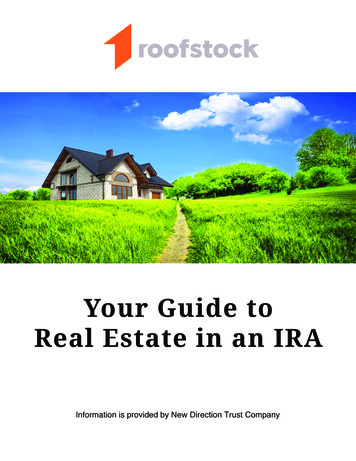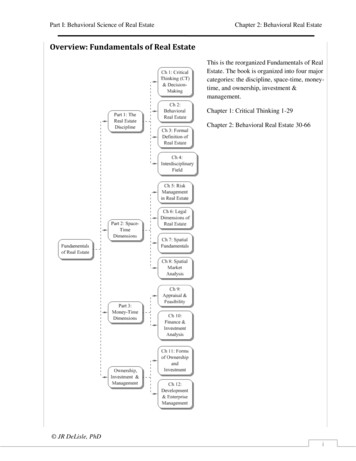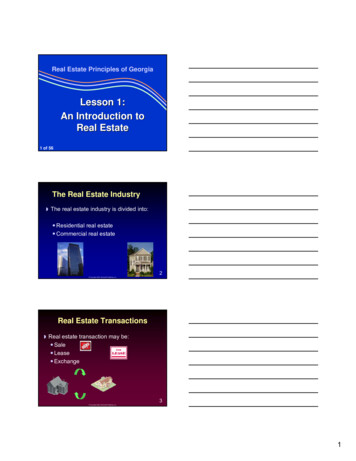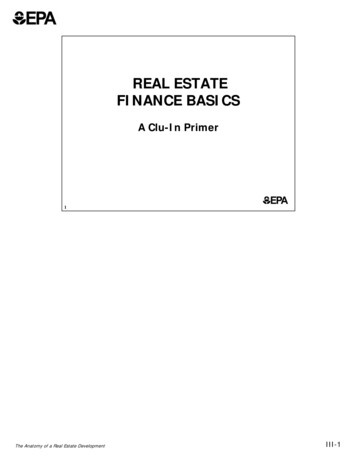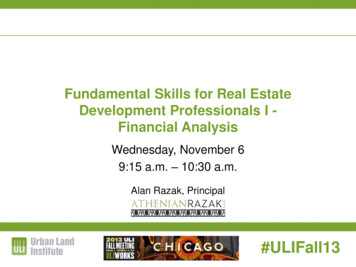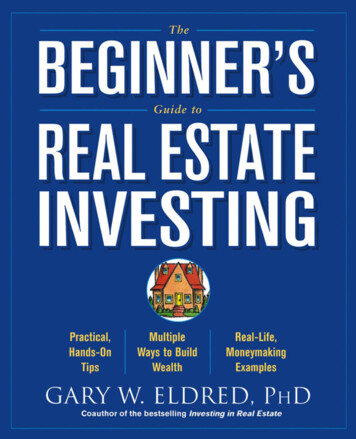
Transcription
TheBEGINNER’SGuide toREAL ESTATEINVESTINGG A RY W. E L D R E D , P h . D .John Wiley & Sons, Inc.
TheBEGINNER’SGuide toREAL ESTATEINVESTING
TheBEGINNER’SGuide toREAL ESTATEINVESTINGG A RY W. E L D R E D , P h . D .John Wiley & Sons, Inc.
This book is printed on acid-free paper.Copyright 2004 by Gary W. Eldred. All rights reserved.Published by John Wiley & Sons, Inc., Hoboken, New Jersey.Published simultaneously in Canada.No part of this publication may be reproduced, stored in a retrieval system, or transmitted in anyform or by any means, electronic, mechanical, photocopying, recording, scanning, or otherwise,except as permitted under Section 107 or 108 of the 1976 United States Copyright Act, withouteither the prior written permission of the Publisher, or authorization through payment of theappropriate per-copy fee to the Copyright Clearance Center, Inc., 222 Rosewood Drive, Danvers,MA 01923, (978) 750-8400, fax (978) 646-8600, or on the web at www.copyright.com. Requeststo the Publisher for permission should be addressed to the Permissions Department, John Wiley& Sons, Inc., 111 River Street, Hoboken, NJ 07030, (201) 748-6011, fax (201) 748-6008.Limit of Liability/Disclaimer of Warranty:While the publisher and author have used their bestefforts in preparing this book, they make no representations or warranties with respect to theaccuracy or completeness of the contents of this book and specifically disclaim any impliedwarranties of merchantability or fitness for a particular purpose. No warranty may be created orextended by sales representatives or written sales materials.The advice and strategies containedherein may not be suitable for your situation.You should consult with a professional whereappropriate. Neither the publisher nor author shall be liable for any loss of profit or any othercommercial damages, including but not limited to special, incidental, consequential, or otherdamages.For general information on our other products and services, or technical support, please contactour Customer Care Department within the United States at (800) 762-2974, outside the UnitedStates at (317) 572-3993 or fax (317) 572-4002.Wiley also publishes its books in a variety of electronic formats. Some content that appears inprint may not be available in electronic books. For more information about Wiley products, visitour web site at www.Wiley.com.Library of Congress Cataloging-in-Publication Data:Eldred, Gary W.The beginner’s guide to real estate investing / Gary W. Eldred.p. cm.Includes index.ISBN 0–471–64711–X (paper)1. Real estate investment. I.Title.HD1375.E353 2004332.63 24—dc22Printed in the United States of America.10 9 8 7 6 5 4 3 2 12004040730
CO N T E N T SWhy This Book?xiPART ONE: MINDSET KNOWLEDGE WEALTH1. Get Started Now13Just Say No to Excuses 3You Must Believe It to See ItSet Goals Now 122. Multiple Paths to Building Wealth719Appreciation in Market Values 19Inflation 21Cash Flows 23Mortgage Payoff (Amortization) 24Buy Below Market Value 25Create Value with Property Improvements 25Improve the Neighbors and Neighborhood26Convert the Use 27Manage and Market Your Properties More Profitably 29Protect Your Profits from the IRS (Tax Shelter) 29Discounted Notes,Tax Liens,Tax Deeds, and Realty StocksPART TWO: HOW TO RAISE THE MONEY3. Strengthen Your Credit Power323537Consistency: Fast Track or FlakeCharacter Counts 38Credit Scores Count Most 40Summing Up 49374. How to Invest Using Little (or None) of Your Own Cash50v
viCONTENTSWhy Low-Cash Deals Magnify Your Returns 50Minimize Your Down Payment with Owner-OccupantFinancing 54Don’t Overlook FHA 57Discover FHA’s Best Kept Secret: The 203(k) Program 59Too Many Vets Pass Up VA Loans 62Even Fannie and Freddie Accept Little- or Nothing-DownLoans 63Summing Up 645. Forget the Banks, Seek Out Seller Financing66Sellers Can Nearly Always Beat the Banks at Their Own Game,But You Must Do More than Ask 67Mortgage (Trust Deed) 70Try a Contract-for-Deed 73Assume a Low-Interest-Rate Mortgage 76“Assume” a Nonassumable Mortgage 796. Five More Techniques to Finance Your Investments83Wraparounds Benefit Buyers and Sellers 83Lease Options 84The Lease-Option Sandwich 90Lease-Purchase Agreements 91Master-Lease an Apartment Building 937. How to Come Up with the Money to Close96Cash Out Some of Your Current Home’s Equity 96Bring in Partners 97Second Mortgages 99Personal Savings 100Sell Unnecessary Assets 100Down-Payment Assistance 101Easy Money—Hard Terms 101Use Credit Cards 105Personal Loans 106Sweat Equity (Creating Value through Renovations) 106Eliminate Your Down Payment with Pledged Collateral 106
ContentsStudent Loans 108Use More Creative Finance8. Here’s How to Qualifyvii108110Be Wary of Prequalifying (and Preapproval) 110You Can Make Your Qualifying Ratios Look Better 112The Application Itself Contains Many Clues to YourIntegrity 122No Rigid Borrowing Limits Apply to CommercialProperties 123PART THREE: HOW TO INVEST FOR MAXIMUM GAIN1279. Twenty-Seven Ways to Find or Create Below-Market Deals129Why Properties Sell for Less (or More) than TheirMarket Value 129Don’t Dilly-Dally with Due Diligence 135How to Find Bargain Sellers 13710. Make Money with Foreclosures and REOs143The Stages of Foreclosure 143Approach Owners with Empathy: Step One 145Some Investors Do Profit from the Foreclosure Auction: StepTwo 148The Benefits of Buying REOs: Step Three 15111. More Sources of Bargains156Federal Government Auctions 156Sheriff Sales 157Buy from Foreclosure Speculators 157Probate and Estate Sales 157Private Auctions 159Short Sale Bargains 16212. Run Numbers Like a Pro170Follow the Construction Cycle171
viiiCONTENTSHow to Profit from the Construction Cycle 171Per-Unit Measures 174Gross Rent Multipliers (GRMs) 176Capitalized Value 177Cash Flow Returns 182Don’t Settle for Market Rates of Appreciation: Create Value18413. How You Can Greatly Increase the Value of YourInvestment Property 185Search for Competitive Advantage 186First, Verify Actual Rent Collections, Not Merely Rental RatesTalk with Tenants 188Set Your Rents with Market Savvy 189Your Apartment Checklist 190Give the Interior a Martha Stewart Makeover 192Safety, Security, and Convenience 194Rightsize the Rooms 195Create More Storage 196Check Noise Levels 198Overall Livability 19914. Twenty-One More Ways to Boost the Value ofYour Properties 200Create Strikingly Attractive Curb Appeal 200Collect More than Rent 203Convert a Garage, Attic, or Basement 204Create an Accessory Apartment 206Create a Special Purpose Use 206Change the Use of a Property 207Cut Operating Expenses 209Gentrification and Other Value Plays 211PART FOUR: ONWARD AND UPWARD TOBUILDING WEALTH 21915. Win What You Want through NegotiationHow to Define Win-Win221221187
ContentsixKnow Thyself 224Know the Property and Neighborhood 224Know the Sellers 225Establish Favorable Benchmarks 227Tit for Tat 228Get Seller Concessions Early 228Come Ready to Buy 228Ask for More than You Expect 229Establish Credibility 230Never Offer to Split the Difference 231List Your BATNAs 232Negotiate for Yourself 233Leave Something on the Table 23516. How to Write Your Purchase Offer236No Single Contract Form 236Make Sure You Draft These Clauses with Care andUnderstanding 237Summing Up 24717. Craft Your Lease to Increase Profits248Achieve Competitive Advantage 248Craft Your Rental Agreement 249Landlording: Pros and Cons 26118. The 12 Secrets of Successful Landlording263The Good News 263Hired Management versus Self-Management 265Before You Buy, Verify, Verify, Verify 269Prepare the Property for Rental 270Craft a Winning Value Proposition 271Attract Topflight Tenants 273Create a Flawless Move-In 276Retain Topflight Residents 277When the Market Supports It, Raise Rents 279Anticipate and Prepare for Special Problems 280Maintain the Property 282
CONTENTSxProcess Move-Outs Smoothly 282Persistently Find Ways to Increase Your Cash FlowKeep Trading Up 284Internet AppendixIndex293287283
W H YT H I SB O O K ?Why this book? In writing The Beginner’s Guide to Real Estate Investing, my intent has been to cover all topics that first-time real estate investors need to know—but to do so in less depth than I’ve included inmy previous Wiley titles.Here you’ll find discussions about credit scoring, mortgages, sellerfinancing, negotiation, foreclosures, bargain-hunting, appraisal, valuation,creating value, cash flow analysis, property management, and dozens ofother topics. In this book, you’ll gain a profit-generating introduction tothe complete range of knowledge you’ll need to begin building wealthin real estate.In other words, another title for this book might have been Real Estate Investing in a Nutshell.This book is directed toward those readerswho want to sample all investment topics in one easy-to-read volume.In contrast, for those readers and experienced investors who prefermore depth on each of the topics discussed herein, I might suggest that,you instead select from some combination of these titles: Investing inReal Estate, 4th ed. (with Andrew McLean), Make Money with FixerUppers and Renovations, Make Money with Small Income Properties,Make Money with Condominiums and Townhouses, The 106 Mortgage Secrets All Borrowers Must Know—but Lenders Don’t Tell, The106 Common Mistakes Homebuyers Make—and How to Avoid Them,3rd ed., and The Complete Guide to Second Homes for Vacations, Retirement, and Investment.xi
xiiWHY THIS BOOK?Either way, whether you select this abridged volume or some combination of my other titles, you’ll find that I always offer my readers themost detailed and practical guides to investing in real estate that areavailable. Although I am quite optimistic on your opportunities to buildwealth with property, I never mislead my readers into believing that thiswealth will come without knowledge, time, and effort.It’s certainly true.You can still get rich in real estate. But you mustlearn how to analyze properties, neighborhoods, and financial risks andrewards. And that’s exactly what my books will help you learn.I wish you good luck and good fortune.Gary W. Eldred
TheBEGINNER’SGuide toREAL ESTATEINVESTING
P A R TONEMindset Knowledge Wealth
C H A P T E R1Get Started NowIn this book, I want to motivate and educate you. I want to get youstarted in real estate. I hope to persuade you that real estate investingcan still lead you to a lifetime of wealth and personal fulfillment. No matter what financial goals youset for yourself, no matter how little cash, credit, orYou can still getincome you currently possess, if you choose to, yourich in real estate.can still build your fortune in real estate.Just Say No to Excuses“But wait a minute,” you say. “You can’t be talking to me. In my area ofthe country, property prices have climbed sky-high. Besides, I reallydon’t have enough cash, credit, or time to get started. And even if I did,real estate seems too complex. I can’t even balance my checkbook.”As I travel throughout the country and talk with would-be beginning investors, I repeatedly hear these types of excuses. But it may surprise you to learn that I’ve heard these same excuses for nearly 30 years.Naysayers Thrive in All Times and PlacesWhen times are good, people fret over the deals they’ve missed. Whentimes are bad, these same folks claim that real estate is no longer a good3
MINDSET KNOWLEDGE WEALTH4investment. Either way, they always find some way to color the futurebleak (see Box 1.1).Yet, since the early 1970s I have seen all types of booms and busts.I have seen 18 percent mortgage interest rates. I’ve lived through themultiple turmoils of double-digit rates of inflation, the disastrous 1986Tax Reform Act (which killed off the most profitablereal estate tax shelter techniques), and the recentYou can makemarket of sky-high prices. Yet I (and nearly all othermoney in any typesavvy investors) have figured out how to makemoney in every one of these market situations andof market.all of the other types of markets in between.Among all the lessons history teaches, none is more certain than thefact that home prices will go up. Regardless of how high you thinkprices are today, they will be higher 10 years from now and much,much higher 20 or 30 years into the future. Don’t make the mistakeof believing that “home prices have reached their peak.” Before youaccept the naysaying of so-called economic experts, take a quicktrip through some of their faulty predictions from years gone by: The prices of houses seem to have reached a plateau, and there isreasonable expectancy that prices will decline. (Time, December1, 1947) Houses cost too much for the mass market. Today’s average priceis around 8,000—out of reach for two-thirds of all buyers. (Science Digest, April 1948) If you have bought your house since the War . . . you have madeyour deal at the top of the market. . . . The days when you couldn’tlose on a house purchase are no longer with us. (House Beautiful,November 1948) The goal of owning a home seems to be getting beyond the reachof more and more Americans. The typical new house today costsabout 28,000. (Business Week, September 4, 1969)(continued)Box 1.1RegretsThose Folks Who Listen to the Naysayers End Up with a Pile of
Get Started Now(Continued) Be suspicious of the “common wisdom” that tells you to “Buy Box 1.1now . . . because continuing inflation will force home prices andrents higher and higher.” (NEA Journal, December 1970)The median price of a home today is approaching 50,000. . . .Housing experts predict that in the future price rises won’t be thatgreat. (Nation’s Business, June 1977)The era of easy profits in real estate may be drawing to a close.(Money, January 1981)In California . . . for example, it is not unusual to find families of average means buying 100,000 houses. . . . I’m confident priceshave passed their peak. (J. E. English and G. E. Cardiff, The ComingReal Estate Crash, Warner Books, 1980)The golden age of risk-free run-ups in home prices is gone.(Money, March 1985)If you’re looking to buy, be careful. Rising home values are not asure thing anymore. (Miami Herald, October 25, 1985)Most economists agree . . . [a home] will become little more thana roof and a tax deduction, certainly not the lucrative investment itwas through much of the 1980s. (Money, April 1986)We’re starting to go back to the time when you bought a home notfor its potential moneymaking abilities, but rather as a nestingspot. (Los Angeles Times, January 31, 1993)Financial planners agree that houses will continue to be a poor investment. (Kiplinger’s Personal Financial Magazine, November1993)A home is where the bad investment is. (San Francisco Examiner,November 17, 1996)Your house is a roof over your head. It is not an investment.(Karen Ramsey, Everything You Know About Money Is Wrong,Reagan Books, 1999)The trends that have produced the housing boom . . . have nearlyrun their course. This virtually guarantees . . . plummeting homeprices and mass foreclosures. . . . (John Rubino, How to Profitfrom the Coming Real Estate Bust, Rodale, 2003)(Continued)5
MINDSET KNOWLEDGE WEALTH6Build Wealth in Any MarketYou’ve heard it said before,“The only constant is change.”And when markets change, that change creates opportunities. Here are just a few examples: When prices appreciate fast, you can “fix and flip” for quick profits. Appreciating prices also give you the tax-free benefit of cash-out refi-nances. Falling interest rates (even with stable prices) reward you with a refi-nance that lowers your monthly payments and increases your cashflows. Depressed markets provide you with an abundance of foreclosures,motivated sellers, and bargain-priced properties. High rates of inflation drive up market interest rates and cut downshort-term demand. That’s the perfect time to look for seller financing,lease options, and low-interest-rate mortgages that you can take over(assume) from the sellers. High rates of inflation also reduce the number of newly constructedhouses because builders must pay higher construction costs andhigher interest rates. Fewer housing starts clearly signals an excellenttime to buy. A slowdown in new housing always foreshadows a jump inprices as growing demand outpaces new supply. (California perfectlyillustrates this point—albeit low housing starts in California are nowbeing caused by tight land-use controls, environmental protection, andrestrictive growth management policies.)These moneymaking examples merely touch upon the multitude ofstrategies you will discover throughout this book, but they illustrate onecentral message that I have advocated throughout my career and in all ofmy writings:Q. When’s the best time for you to invest in real estate?A. Today.But don’t jump to the wrong conclusion. By saying “invest today,” Idon’t mean that you can never go wrong. Rather, I mean that there’snever a wrong time to invest if you choose the right strategy. And that’swhat I’m going to show you.
Get Started Now7You Must Believe It to See ItGiven the large rewards that most savvy real estate investors haveachieved over the years, I’ve often wondered why most people fail to invest in real estate. After much thought and talkswith hundreds of would-be investors, I’ve come toThe time to startthis conclusion: Most people simply don’t believe inthe future and they don’t believe in themselves.really is now.As a result, most people don’t believe in theirability to actually make big money in real estate.These negative thinkers erect a wall of excuses that blocks their vision.This wall prevents them from seeing the profit potential that lies in frontof them. So, will you join the ranks of the naysayers? Or will you openyour mind to a promising future?Imagine the FutureThink about your future. Imagine you’re reading the real estate classifiedads 10 years from today. What do these ads of tomorrow say?Are property prices higher or lower than they are today? Are rentlevels higher or lower than they are today? If you believe in the continuing growth of the United States, you must believe that just as with everypast decade, today’s property prices and rent levels will look cheap relative to where they will stand 10 years from now (see Table 1.1).Reprogram Your Self-TalkAsk yourself whether you really want to benefit from those future gains.Or would you prefer to merely watch others reap these near-certainTable 1.1Year1970197519801985Historical Growth in Median Home PricesPrice tical Abstract of the United States 2003, p. 723Price 95,500113,100138,400182,000 (est.)
MINDSET KNOWLEDGE WEALTH8profits? If you do want to succeed—yet you feel blocked by excuses—then reprogram your self-talk.What Is Self-Talk? In his mind-opening book, What To Say When YouTalk to Yourself (Pocket Books, 1986, p. 25), Shad Helmstetter writes,You will become what you think about most. Your success orfailure in anything, large or small, will depend on your mentalprogramming—what you accept from others, and what yousay when you talk to yourself.After years of study, this nationally renowned psychologist hasfound that as a matter of habit, most of us swamp our optimism andhence our motivation to change for the better with negative self-talk.Think about your own thoughts. Do you accept thenegative as “true” or “the way things really are”? Doyou frequently focus on risks rather than opportuniYou must believeties? Ponder these familiar excuses that you’ve eiit to see it.ther said to yourself or heard others say hundreds oftimes: I can’t remember names.It’s just no use.No matter what I do, I just can’t keep the weight off.I never have enough time.I’m just too disorganized.I’m no good at math.I’m always running late.Now think about this: If you program yourself with these types ofnegative self-descriptions, will you undertake any serious efforts tochange these or other undesirable traits and habits? Of course not! Andthe same thing stands true for those beliefs (self-talk) that can block youfrom getting started in real estate. Once again, think about the types ofexcuses that I frequently hear: Prices are too high.I can’t afford to buy.I missed so many good opportunities.I can’t get financing because of my credit problems.
Get Started Now9 It’s too late to get started now. I should have invested years ago.Real estate will take up too much time.I don’t want to deal with tenants, stopped-up toilets, leaky roofs,or broken furnaces. I don’t know enough to get started—or even how to get started. We don’t have any extra cash. We’re spending more than wemake.You may or may not identify with any of thesespecific excuses. But unless you discipline your selftalk far better than most people, you undoubtedlyUse self-talk tohave at least a few areas where your false beliefsdiscover andkeep you from taking positive action.develop your realAs to real estate investing, I urge you to repropotential.gram your negative self-talk and limiting beliefs withmind-opening questions such as these: What are six ways I can save more and spend less?Where are the best neighborhoods to find bargain-priced properties?How might I persuade the sellers to accept owner financing?Who do I know with money that I could partner with?How can I boost my credit score?How can I improve this property to enhance its value by thelargest amount?Ideally (at least concerning real estate investing), you must eraseyour negative self-talk tapes. Then rerecord positive self-talk. Instead ofbringing yourself down with talk or beliefs that create undesirablehabits, attitudes, and outcomes, focus on the behavior and belief patternsthat will lead you where you want to go. Ask yourself questions that leadto opportunities and problem-solving.Why Questions? To solve any problem, first ask a question. Questions and the habit of asking them lead you to discover possibilities. People (usually underachievers) who merely settle for preprogrammedconclusions won’t ask questions. Because they believe they alreadyknow the answers, they unwittingly overlook the choices and the possibilities the world is offering them. You must always realize that if youdon’t like the program you’re living, you’re free to switch the channel.
MINDSET KNOWLEDGE WEALTH10Questions helpyou achieve yourgoals.Lifelong Job? The Wall Street Journal (September 23, 2003, p. D2) published a recent survey byAARP (formerly known as the American Associationof Retired Persons). The Journal reporter writes,According to a new study, many American workers are planning to push their retirement age well into their 70s,or in some cases, their 80s . . . largely because of deep cracks intheir nest eggs. . . . These findings quantify a significant shift inthinking that is resulting largely because of the stock marketdownturn and historically low interest rates on the more conservative investments. . . . The need for money was named asthe primary motivation by workers who plan to stay on thejob . . .When I read the results of surveys such as this, two thoughts come tomind:1. Why didn’t more of these now-disappointed workers investmore money in real estate instead of stocks?2. And more important, why don’t they at least get started now?Starting late most assuredly beats never starting at all.To know that most of these folks are now rushing into low-yieldingcertificates of deposit, annuities, and government bonds once again reinforces my message here. They’re choosing low yields because they holdfalse beliefs about real estate investing. No rationalperson could possibly choose lifelong employmentand meager returns on so-called safe investmentsNo one needs tosuch as annuities, bonds, and CDs if they really beaccept low yields.lieved (and understood) the possibilities thatpresently exist in real estate.Two More False Beliefs In his popular book The Four Pillars of Investing (McGraw-Hill, 2003), William Bernstein repeats two more widely heldmyths of modern investing. You’ve heard them before. But they’re false.1.“No guts, no glory.” Bernstein claims that if you want to increase your potential rewards from investing, you must learnto accept more risk. Bernstein writes,“Whether you invest in
Get Started Now11stocks, bonds, or for that matter real estate, you are rewardedmainly for your exposure to one thing—risk.”2. “The market is smarter than you are.” Here, Bernsteinmerely repeats the “efficient market” theory of modern finance. In an efficient market, all asset prices supposedly reflect their true market value. According to Bernstein, you cannever find bargain-priced investments.As they pertain to real estate, both of Bernstein’s so-called pillars ofinvesting are perfectly silly. When you invest in real estate, you gain thesetwo profit-generating benefits:1. In real estate, you are not merely being rewarded fortaking risk. You are rewarded for applying your intelligenceand market savvy. You are rewarded for providing a target market (tenants or buyers) a property that offers better value thancompeting properties.2. You can beat the market. When you put into action thesteps and techniques described in this book, you will discoverand create opportunities that the majority of property owners(along with those naysayers who shout from the sidelines)consistently miss.Nevertheless, these widespread false beliefs can actually work toboost your investment returns. Because financial planners and economists (who typically have no meaningful experience with real estate investing) give such faulty advice, their advice keeps investor competitionfor properties far below the level that would otherwise exist.In other words, as long as most potential inThe false beliefs ofvestorsbelieve that to earn big returns in real estateothers boost yourthey must take big risks, they will continue to standopportunities.on the sidelines. They will leave more opportunitiesfor you.Summing Up Self-Talk and False Beliefs No doubt, today’s real estate market will challenge you. But if you keep your eyes on the prizeand your mind filled with possibilities, you will discover multiple waysto build real estate wealth (see Chapter 2). As the dynamic speaker, Les
MINDSET KNOWLEDGE WEALTH12It’s possible, andBrown, says in his motivation video, It’s Possible, theroad may not be easy, but it’s worth it!it’s worth it!Set Goals NowWhat’s a realistic dream? It’s a goal with a deadline. To get started now,act now to reset your priorities.Most of us squander our time and our money pursuing transientpleasures. A new car, a trip to Europe, 10 lunches, TV football weekends—we waste our precious talents and resources. As a result, we suffer long-lasting regrets. But if you do today what others won’t do,tomorrow you’ll be able to live in the enviable style that most peoplewill never be able to experience.Set goals now. Precisely what goals depend on where you are todayand what you wish to achieve.As a starting point, nearly all successful investors agree that if youtruly want to build wealth, you will set these stringent goals:1. Dramatically cut your spending and increase your cash savings.2. Shape up your credit profile.3. Closely read the real estate classifieds in your local paper.4. Diligently telephone sellers and go out and look at properties.5. Join a real estate investment club.6. Read at least five more books on real estate within the nextthree months. Also read at least three books by “personalcoaches” such as Tony Robbins, Wayne Dyer, Les Brown, ShadHelmstetter, and Maxwell Maltz.7. Commit to making your first real estate investment within thenext three months.Spend Less, Save MoreWhen Jack Holden was asked how his family got started investing in realestate, here’s how he responded. “We scraped, borrowed, and leveragedfrom every resource we had to muster the funds we needed. . . . Forseed money we cashed in saving bonds and borrowed from our insur-
Get Started Now13ance policies. . . . The entire family went on an austerity plan to cut backour food, travel, and entertainment expenses. Today we’re thankful wemade those early sacrifices.”Thankful, yes, and also wealthy. Because oftheir disciplined spending, saving, and investing, the Holdens (an otherwise average family) built a real estate net worth of 4.7 million that includes not only their home equity of 600,000, but also a variety ofrental houses and small apartment buildings.Like most people who make big money in property, the Holdensdidn’t start out with cash. As Jack Holden says, his family scrimped,saved, leveraged, and borrowed every way they could.So what’s the lesson that you can learn? To buildwealth in real estate, don’t wait until you get the cashor credit and then decide to invest. No! First, commitCommit toyourself to investing, then figure out how to come upbuilding wealthwith the money. You can keep “wishing and a-hopbefore you get theing” to invest someday. Or you can now decide toown property and immediately begin to shape upmoney to invest.your finances and create a plan to invest.Want some ideas to start your own austerityplan, raise cash, and strengthen your credit? Trythese suggestions.Set today’sNever Say Budget No one likes to budget. Itprioritiessounds too much like work. Instead, think priorities.according to whatThink reward. The quality of your life improves asyou want toyou allocate your money according to your highestvalues. If you truly want to own investment real esachieve within fivetate, put your money where it can yield the smartestyears.returns. For example . . .Stop Paying Rent If you don’t yet own your own home, rent is probably your biggest money waster. Can you figure out how to eliminate orreduce your rent payments? Can you switch to a lower-cost apartment?Can you house-share? Can you find a house-sitting job for the next 3 to12 months? Can you move back with your parents or stay rent-free withrelatives or friends? Bank your rent money for 6 to 12 months, and forthe rest of your li
The beginner s guide to real estate investing / Gary W. Eldred. p. cm. Includes index. ISBN 0 471 64711 X (paper) 1. Real estate investment. I.Title. HD1375.E353 2004 332.63 24 dc22 200404
